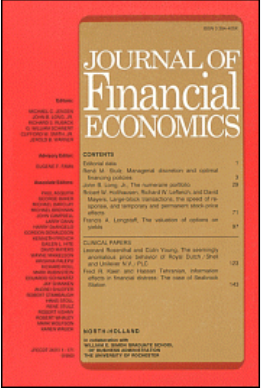预期特殊波动率
IF 10.4
1区 经济学
Q1 BUSINESS, FINANCE
引用次数: 0
摘要
我们使用超过19,000家CRSP上市公司近8000万的日收益来建立实现特质方差的最佳预测模型。比较多个模型的预测,我们发现流行的鞅模型表现最差。使用均方根误差(RMSE)来判断模型性能,ARMA(1,1)模型在样本外测试中对约46%的公司表现最佳。ARMA(1,1)模型提供的平均RMSE在统计上显著低于所有替代模型,并且在不是最好的情况下也表现良好。它的预测逆转了对已实现方差的巨大、意想不到的冲击。当使用这个模型重新审视特殊风险和回报之间的关系(IVOL难题)时,我们没有发现一个显著的关系。IVOL难题与一组非常小的观测密切相关,其中鞅预测过度预测了未来实现的方差。这些极端的观察结果与众所周知的与IVOL难题相关的公司特征相关,例如由高买卖价差和“MAX”效应衡量的流动性差。本文章由计算机程序翻译,如有差异,请以英文原文为准。
Expected idiosyncratic volatility
We use close to 80 million daily returns for more than 19,000 CRSP listed firms to establish the best forecasting model for realized idiosyncratic variances. Comparing forecasts from multiple models, we find that the popular martingale model performs worst. Using the root-mean-squared-error (RMSE) to judge model performance, ARMA(1,1) models perform the best for about 46 % of the firms in out-of-sample tests. The ARMA(1,1) model delivers an average RMSE that is statistically significantly lower than all alternative models, and also performs well when not the very best. Its forecasts reverse large, unexpected shocks to realized variances. When using this model to revisit the relation between idiosyncratic risk and returns (the IVOL puzzle), we fail to find a significant relation. The IVOL puzzle is closely connected to a very small set of observations where the martingale forecast over-predicts the future realized variance. These extreme observations are correlated with well-known firm characteristics associated with the IVOL puzzle such as poor liquidity as measured by high bid-ask spreads and the “MAX” effect.
求助全文
通过发布文献求助,成功后即可免费获取论文全文。
去求助
来源期刊

Journal of Financial Economics
Multiple-
CiteScore
15.80
自引率
4.50%
发文量
192
审稿时长
37 days
期刊介绍:
The Journal of Financial Economics provides a specialized forum for the publication of research in the area of financial economics and the theory of the firm, placing primary emphasis on the highest quality analytical, empirical, and clinical contributions in the following major areas: capital markets, financial institutions, corporate finance, corporate governance, and the economics of organizations.
 求助内容:
求助内容: 应助结果提醒方式:
应助结果提醒方式:


